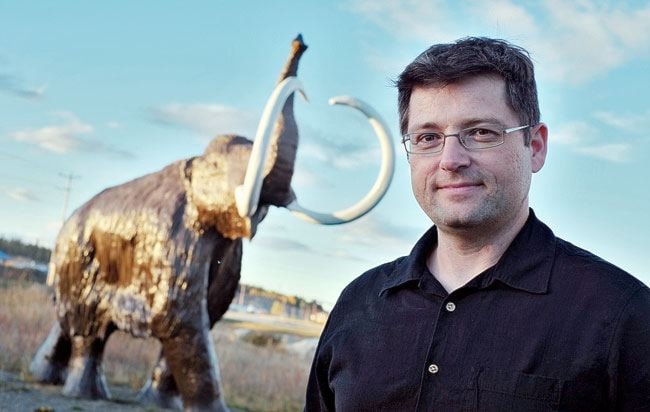Julius Csotonyi is a time traveller.
With his scientific mind and artist’s eye, he produces a vision of the prehistoric world, a time before humanity.
“My whole mission is to show things we cannot see for ourselves,” said Csotonyi. His preferred destination: the age of dinosaurs.
During a presentation at the Yukon Beringia Centre last week, Csotonyi explained the job of paleo-artist is to take the scientific data produced by paleontologists and bring it to life.
The Edmonton-based artist has created images for Science Magazine, National Geographic and Scholastic publishing, and large-scale murals for the Royal Tyrrell Museum, the Royal Ontario Museum and the Houston Museum of Natural Science, among others.
As scientific illustration, Csotonyi’s images must be rooted in hard fact. That means anatomy, behaviour patterns, environment and plant life, even lighting conditions, are extrapolated from evidence in the fossil record and ecological history.
A fossil of a mummified dinosaur found in 2007 was invaluable for understanding skin textures and soft tissue construction, and the contents of the gut gave valuable insight into the diet, and flora, of the beast’s world. Before that, clues were extrapolated only from fossilized bones.
“This is the golden age of dinosaur research,” said Csotonyi. “I’m fortunate that I’ve been brought into the loop in new discoveries.”
Working closely with scientists and museums for the bulk of his work means Csotonyi needs to be flexible for late-breaking discoveries, which happen often.
With that in mind, Csotonyi has embraced digital painting in programs like Photoshop. A digital piece, built with different layers, allows the artist to make changes as new evidence emerges, instead of starting from scratch. Not a bad tool when it takes days to build up a piece, some more than 45 metres long and three metres tall.
One feathered dino illustration was nearly complete when new evidence in sub-cellular structures in the feathers indicated specific colouration. His red anchiornis ended up being dark grey with white and cinnamon on the tail and a red crest on its head. “I’m connected to the frontier of science in this area, and it’s very exiting for me.”
With no formal art education, it’s been an unexpected career path for Csotonyi, who was trained as a scientist. He earned his PhD studying the micro-life forms living in extreme environments, like salt springs or hydrothermal vents at the bottom of the ocean. This work honed his eye for detail, he said.
Since childhood, he always liked to draw dinosaurs. “I thought the artwork would be a hobby.” By 2005, paleo art started taking up more and more of his time, slowing down his PhD research.
Once he finished his schooling, his art career took off. He said that as the amount of research grows, the amount of work for paleo artists grows, and public interest grows, in an upward spiral. “The field has exploded,” he said.
His specialized niche keeps him busy: “I rarely find time to play around with it,” he said, but he’s happy for the work. “I try not to turn down anything - but that’s because I forego sleep.”
An image of high Arctic camels of the Pliocene period was recently published in Ice Age Old Crow, a Yukon government publication. Csotonyi hopes to collaborate with Yukon paleontologist Grant Zazula for future projects.
His work has appeared on coins from the Canadian Mint, and his first collection, The Paleo Art of Julius Csotonyi, will be published next year by Titan Books.
More of Csotonyi’s work can be seen at his website, www.csotonyi.com
Contact Ian Stewart at
istewart@yukon-news.com
